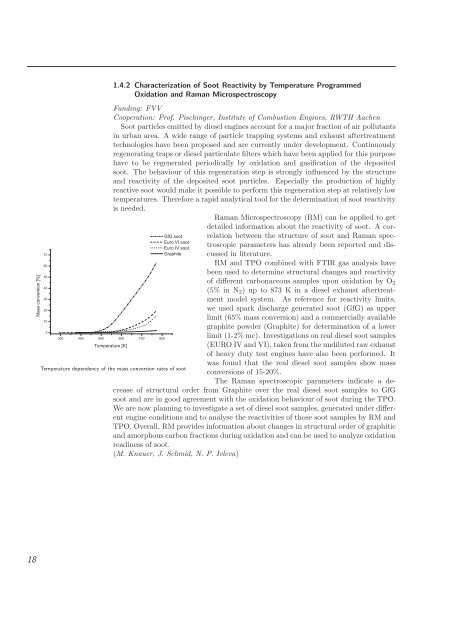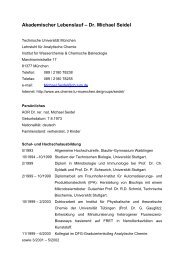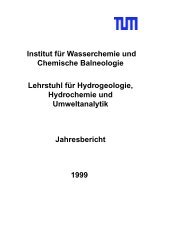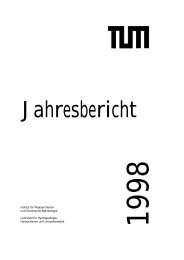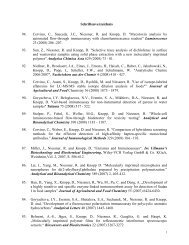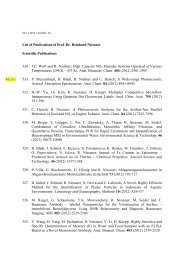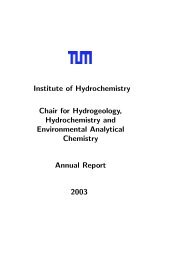IWC Annual Report 2008 - Institut für Wasserchemie und chemische ...
IWC Annual Report 2008 - Institut für Wasserchemie und chemische ...
IWC Annual Report 2008 - Institut für Wasserchemie und chemische ...
You also want an ePaper? Increase the reach of your titles
YUMPU automatically turns print PDFs into web optimized ePapers that Google loves.
Mass conversion [%]<br />
18<br />
70<br />
60<br />
50<br />
40<br />
30<br />
20<br />
10<br />
0<br />
1.4.2 Characterization of Soot Reactivity by Temperature Programmed<br />
Oxidation and Raman Microspectroscopy<br />
F<strong>und</strong>ing: FVV<br />
Cooperation: Prof. Pischinger, <strong>Institut</strong>e of Combustion Engines, RWTH Aachen<br />
Soot particles emitted by diesel engines account for a major fraction of air pollutants<br />
in urban area. A wide range of particle trapping systems and exhaust aftertreatment<br />
technologies have been proposed and are currently <strong>und</strong>er development. Continuously<br />
regenerating traps or diesel particulate filters which have been applied for this purpose<br />
have to be regenerated periodically by oxidation and gasification of the deposited<br />
soot. The behaviour of this regeneration step is strongly influenced by the structure<br />
and reactivity of the deposited soot particles. Especially the production of highly<br />
reactive soot would make it possible to perform this regeneration step at relatively low<br />
temperatures. Therefore a rapid analytical tool for the determination of soot reactivity<br />
is needed.<br />
300 400 500 600 700 800<br />
Temperature [K]<br />
GfG soot<br />
Euro VI soot<br />
Euro IV soot<br />
Graphite<br />
Temperature dependency of the mass conversion rates of soot<br />
Raman Microspectroscopy (RM) can be applied to get<br />
detailed information about the reactivity of soot. A correlation<br />
between the structure of soot and Raman spectroscopic<br />
parameters has already been reported and discussed<br />
in literature.<br />
RM and TPO combined with FTIR gas analysis have<br />
been used to determine structural changes and reactivity<br />
of different carbonaceous samples upon oxidation by O2<br />
(5% in N2) up to 873 K in a diesel exhaust aftertreatment<br />
model system. As reference for reactivity limits,<br />
we used spark discharge generated soot (GfG) as upper<br />
limit (65% mass conversion) and a commercially available<br />
graphite powder (Graphite) for determination of a lower<br />
limit (1-2% mc). Investigations on real diesel soot samples<br />
(EURO IV and VI), taken from the <strong>und</strong>iluted raw exhaust<br />
of heavy duty test engines have also been performed. It<br />
was fo<strong>und</strong> that the real diesel soot samples show mass<br />
conversions of 15-20%.<br />
The Raman spectroscopic parameters indicate a de-<br />
crease of structural order from Graphite over the real diesel soot samples to GfG<br />
soot and are in good agreement with the oxidation behaviour of soot during the TPO.<br />
We are now planning to investigate a set of diesel soot samples, generated <strong>und</strong>er different<br />
engine conditions and to analyse the reactivities of those soot samples by RM and<br />
TPO. Overall, RM provides information about changes in structural order of graphitic<br />
and amorphous carbon fractions during oxidation and can be used to analyze oxidation<br />
readiness of soot.<br />
(M. Knauer, J. Schmid, N. P. Ivleva)


